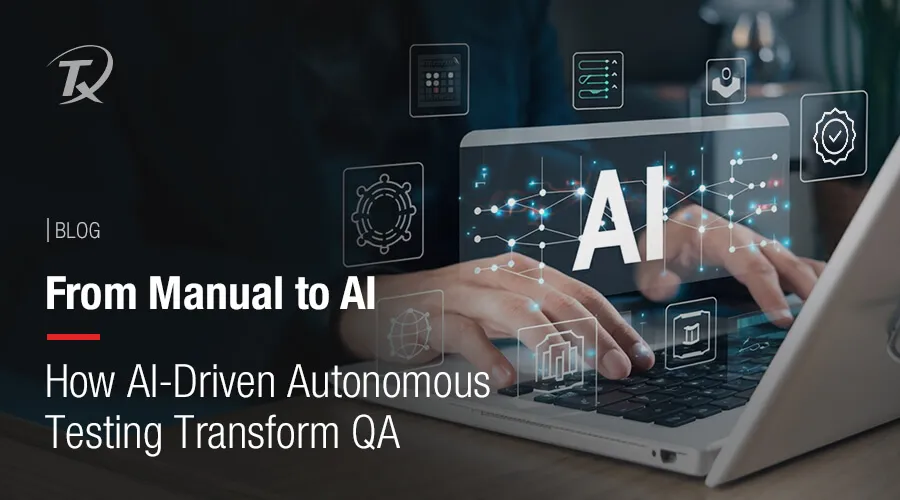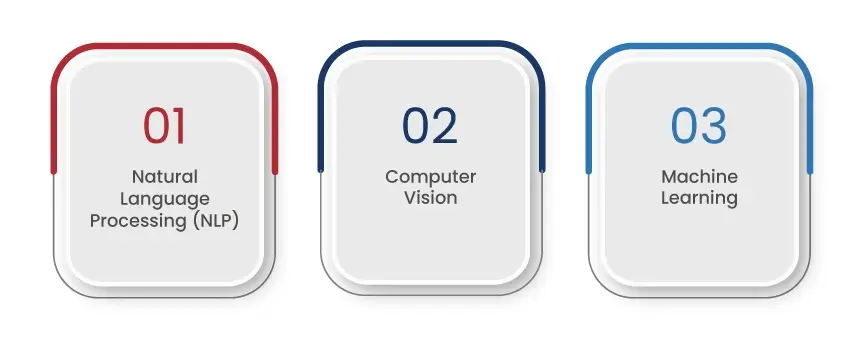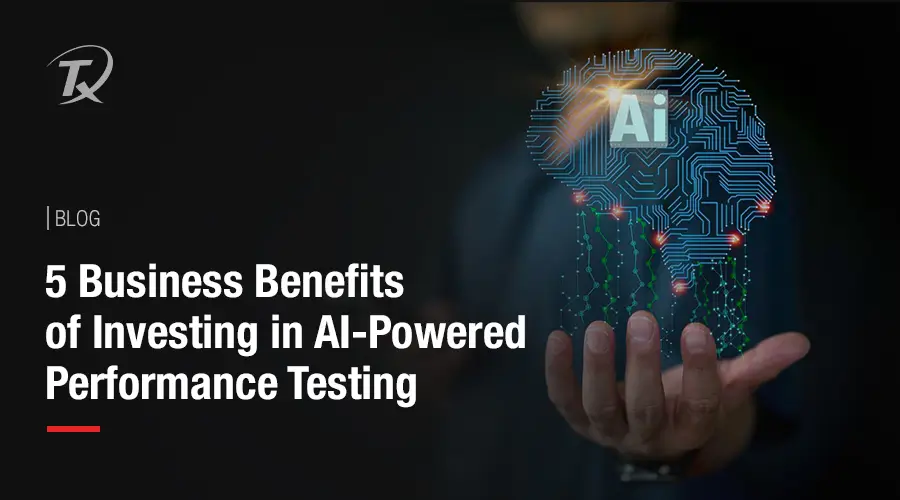
- Understanding the Role of AI in Software Quality Assurance
- Roadmap to AI-driven Autonomous Testing
- Manual Testing Vs AI-driven Autonomous Testing
- Future of AI-driven Autonomous Testing in Software Quality Assurance
- How Can Tx Assist You With AI-Driven Autonomous Testing?
- Summary
Artificial Intelligence (AI) is taking quality assurance (QA) to a new horizon. According to sources, the market size of AI in the quality assurance domain will grow at a CAGR of 35.7% by 2030, making it a $1,339.1 billion industry. The value AI brings by optimizing QA processes and improving efficiency can’t be ignored by businesses that want to scale with the new tech trends. Enterprises that know the value of AI-driven QA are on the path to gaining a strong competitive advantage.
AI tools are fast to act, detect patterns/anomalies missed by human testers, and can simulate user behaviors, delivering a comprehensive view of software performance. Companies can fast-track their development cycles, improve software quality and reliability, and deliver high-performing products to increase customer engagement.
Understanding the Role of AI in Software Quality Assurance

Software testing is a long, time-constrained task involving test suite development, test data generation, and test case management. Manual testing is prone to errors, which, in turn, increases costs and extends project delivery timelines. Leveraging AI in quality assurance can address the drawbacks of traditional testing and can expedite the whole process. AI can undertake various tasks that were previously handled by manual testers. The following are the technologies that will be involved here:
Natural Language Processing (NLP):
It involves understanding, interpreting, and responding to human language while considering linguistic exceptions. This means AI can read and decrypt QA requirements written in plain language and convert them into test cases or automation scripts.
Computer Vision:
It analyzes and interprets visual data and detects anomalies in the UI, allowing QA teams to perform more accurate visual regression testing.
Machine Learning:
ML models enable AI systems to learn from data and past experiences without programming. QA teams can train their AI models by leveraging their testing data, and they can fine-tune the test data patterns and recommendations, making it organization specific.
Also, leveraging AI in the quality assurance processes would take a closer approach to autonomous testing.
Roadmap to AI-driven Autonomous Testing

Stage 1: No QA: Minimal or no testing is performed.
Stage 2: Ad hoc Testing: Informal testing processes handled by individuals.
Stage 3: Manual Testing: Manual testers execute structured test cases.
Stage 4: Test Automation: Test scripts automate repetitive tests and run without human supervision.
Stage 5: AI-Powered Testing: AI generates and maintains test scripts and assists testers.
Stage 6: Autonomous Testing: AI is responsible for the entire QA process, from creating test cases to executing them and analyzing the results.
The journey to autonomous testing can be seen as how QA maturity scales in multiple stages. The above-mentioned flow represents the evolution of QA, from no testing to self-driven AI-enabled testing. This shows how enterprises rely heavily on AI and modern technology, with each step highlighting improvement in accuracy, value delivery, and scalability. Enterprises generally go through these stages to reduce their manual QA efforts and improve test case coverage and product quality as their business grows.
Manual Testing Vs AI-driven Autonomous Testing
|
Aspect |
Manual Testing |
AI-driven Autonomous Testing |
|
Test Execution |
Performed by manual testers using written test cases. |
Executed automatically, leveraging AI-driven algorithms without human supervision. |
|
Test Design |
Test cases are created manually based on use cases and QA requirements. |
AI models analyze code, usage data, and changes to generate relevant test cases. |
|
Speed & Scalability |
The whole process is time-consuming and does not scale well for large, complex systems. |
High-speed execution and can easily scale across environments and large datasets. |
|
Adaptability to Changes |
Needs manual updates whenever requirements or code change. |
Uses ML to adapt test coverage dynamically based on detected code changes. |
|
Error Detection |
Prone to human oversight; limited in detecting unexpected behavior. |
Capable of identifying edge cases and behavioral anomalies using pattern recognition. |
|
Regression Testing |
Labor-intensive and repetitive. |
Efficient; reuses test assets intelligently and continuously validates builds. |
|
Test Coverage |
Limited by time and human capacity. |
Broader coverage through automated exploration and decision-making. |
|
Maintenance |
Requires continuous manual upkeep of test scripts. |
Self-healing mechanisms adapt tests to UI/code changes automatically. |
|
Tool Dependency |
Often tool-agnostic, but it depends heavily on manual effort. |
Relies on platforms using AI, ML, and natural language processing (NLP). |
|
Cost Efficiency |
Higher operational costs due to manual effort and time. |
Lower long-term costs through automation, though initial setup may be complex. |
Future of AI-driven Autonomous Testing in Software Quality Assurance

The software testing industry is already on the path to autonomy. The currently established automation testing approach is moving towards AI-driven autonomous testing, although it’s still only in the infant stage. AI technologies need time to get trained and integrated into a business infrastructure. So, it will take some time, but eventually, enterprises will recognize the complete benefits of leveraging AI in quality assurance. The following are some of the potential aspects:
AI-Powered Test Case Generation:
After analyzing and comprehending an enterprise’s testing requirements, AI can suggest test cases and generate test scripts by itself. However, the QA teams must feed AI with quality data and testing sessions to make this possible.
Autonomous Test Orchestration:
By granting AI access to real-time organizational test data, businesses can manage E2E testing processes seamlessly. Teams can automate test case scheduling according to available resources, make accurate decisions for test execution, and streamline the whole QA environment.
Self-Healing Tests:
Autonomous test scripts adapt in real time without breaking when UI elements or APIs are updated. Teams will use AI-powered locators and pattern recognition algorithms to identify equivalent endpoints depending on context or historical data.
AI-Powered Visual Testing:
There’s an issue with the automation test scripts, as they might throw false positives. AI-powered visual testing will help mitigate this issue by better detecting true visual bugs that might have a negative impact on the user.
DevOps Integration:
Autonomous testing is rapidly being implemented into DevOps practices to create a seamless, continuous integration pipeline for Dev, QA, and release. Quality checks will be integrated at every step, enabling enterprises to release products much faster and with higher assurance.
How Can Tx Assist You With AI-Driven Autonomous Testing?
Transformation demands more than speed. It requires intelligence, accuracy, and resilience. Businesses nowadays require a QA solution that is fast, scalable, and can evolve. AI-driven autonomous quality assurance can be all of it. The collaboration between AI and human intelligence would deliver more comprehensive and effective testing solutions. At Tx, we can assist you in unlocking the perks of using AI in quality assurance processes by enabling autonomous software testing.
By leveraging AI/ML-driven practices, we can help you speed up your QA process in the DevOps chain and grow your business. We combine human expertise with AI capabilities to optimize test coverage and automate your QA lifecycle. Our advanced AI-based NGAutomate and NGHyperAutomate accelerators enable flawless and faster application releases while considering excellent quality and customer satisfaction.
Summary
AI is transforming software testing by enabling autonomous testing, where systems can create, run, and adapt tests without manual input. This reduces human error, improves test coverage, and keeps pace with rapid development changes. From identifying bugs to updating tests automatically, autonomous testing streamlines the entire QA process. Integrated with development workflows, it helps deliver reliable software faster. With expert support and AI-powered tools, Tx helps its clients adopt autonomous testing for better performance and efficiency. To learn how Tx can assist you, contact our AI experts now.
Discover more
Get in Touch
Stay Updated
Subscribe for more info




